ARTICLE 4
The Development of the US Army Dog Gas Mask

| _____During WWII many countries developed gas masks for animals. And dogs in particular had various integral roles during the war. For the US military, the German Shepherd was typically the dog of choice, and was used for patrol duty, scouting, anti-sabotage duty, message delivery and even sometimes mine detection. Because of their many uses during wartime, gas masks were needed to protect dogs as well as their human counterparts. This however, was not a new concept. During WWI, very rudimentary dog gas masks were made by several countries. And in the US, an early attempt to provide dogs with a protective mask was made in 1926. The E1R1 Dog Gas Mask (see below) was a strictly experimental mask, assembled to illustrate the concept of a protective respirator for canines. It consisted of a muzzle piece constructed of six layers of impregnated cheesecloth and a head piece made from leather that covered the dog's head, ears and part of the dog's neck. Leather straps were used like belts to tighten the mask around the dog's neck, creating a gas tight seal. Two circular eye pieces were positioned on either side of the leather head piece to allow for sufficient vision. The E1R1 was a small mask, made to fit medium to small sized dogs of approximately 50-60 pounds. |
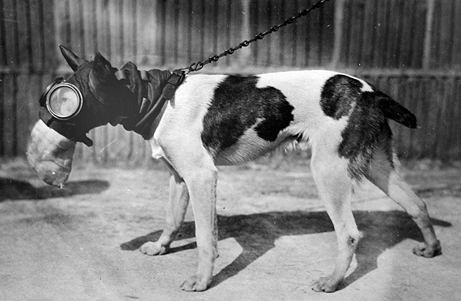 ABOVE: The E1R1 as worn, photographed at Edgewood Arsenal, March 7, 1926.
ABOVE: The E1R1 as worn, photographed at Edgewood Arsenal, March 7, 1926. |
|
ABOVE: An E1R1 as it exists today. Note the missing neck straps. |
| _____In October of 1926, the E1R1 project was dropped and no further attempts to improve upon this design were pursued. However, in April of 1940, the Chemical Warfare Service asked about the possible use of dogs in the theater of war, but the provision of gas masks for dogs was declined. Despite this, in mid 1942, experimentation to design a new dog gas mask begun. In December of 1942, this was made official by way of an order from the chief of the Chemical Warfare Service. Several masks went into experimental production, including two masks made from large pieces of clear plastic material with hoses attached to child sized filters (the E3R4 and the E6R2). In addition to these interesting designs, several other peculiar experimental dog masks were tested (see below). |
|
|
ABOVE: The E3R4 dog gas mask. |
ABOVE: The E6R2 dog gas mask. |
|
|
ABOVE: The E4R3 dog gas mask. |
ABOVE: The E5R1 dog gas mask. |
| _____Experimentation continued into 1943, until it was found that two masks (the E12R8 and the E43R3) had the most potential.
Both masks were made from coated canvas duck, which was quite
rigid and could be stitched into a shape appropriate for
the dog's muzzle. The E12R8 used a single E32R11 filter
cartridge that was fixed to the front of the muzzle piece.
Several horizontal slits (see below) allowed for inhaled
air to pass over the dog's snout. A M8 exhale valve was
positioned on the bottom-front of the mask for expired air
and a hard cellulose acetate eye shield was glued into place
to offer a wide field of view. On the inside, two thick
rubber collars were used to create a seal around the dog's
head and snout. To hold the mask on the dog's head, two
adjustable canvas straps were secured behind the animal's
ears. When not use, the mask was carried by the handler
in a khaki canvas bag. The success of the E12R8 was limited
to field tests, were the mask's filter placement caused
the mask to get jarred and dislodged while on the dog's
head (due to the animal's natural tendency to carry its
head low to the ground). Also, having the filter on the
front of the mask caused dirt and refuse to clog the inlet
slits. The problems encountered during these trials ultimately
found the E43R3 to be more successful. Thus, it was standardized
the US Army M6-12-8 Dog Gas Mask. Because the E12R8 was
never standardized, it was manufactured in very limited
numbers, making surviving examples extremely scarce. |
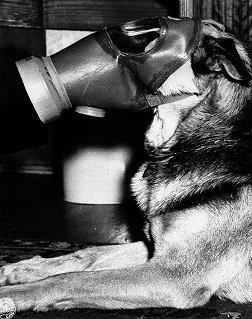 ABOVE: The E12R8 as worn.
ABOVE: The E12R8 as worn. |
|
ABOVE: A nice comparative view of the M6-12-8 and the E12R8. |
| _____While
the shape and size of the M6-12-8 (originally designated
the E43R3) is very similar to the E12R8, the configuration
used for the M6 is quite different. The M6 used two M12
filter disks (identical to those used on the Navy NC-1)
that were attached to each side of the mask instead of a
single unit attached to the front. This setup most likely
proved more serviceable in the field because the dog's natural
tendency to carry its head low to the ground did not interfere
with the position of the filter. In addition, breathing
resistance was probably reduced. However, it was found that
clogging of the filter inlet holes was still a problem.
Consequently, a metal disk (designated the E4R2 Mud Guard)
was fitted over each filter's inlet hole to deflect mud
and other refuse. Clogging was also a problem with the exhale
valve. While the E12R8 used the standard M8 outlet valve,
the M6-12-8 used a non-guarded circular rubber outlet valve
(see below). This system helped prevent clogging and most
likely also served as a slobber drain. For suspension, the
M6 used a thicker fabric harness and a wide head pad that
was adjusted behind the dog's ears. The inner mask was similar
to the E12R8 with a wide rubber collar that created the
necessary seal around the dog's muzzle. The M6 was carried
in a waterproof carrier (designated the E10R1 and later
standardized the M8 carrier) very similar to the M7 carrier
used with the M5-11-7 Assault Service Gas Mask. Today, the
M6-12-8 Dog Gas Mask is among the rarest of the US Army
WWII era masks, as only 1,409 were manufactured during the
war. In 1969 the M6-12-8 was officially declared obsolete,
and no attempt to provide NBC protection for canines has
been attempted by the Army since. |
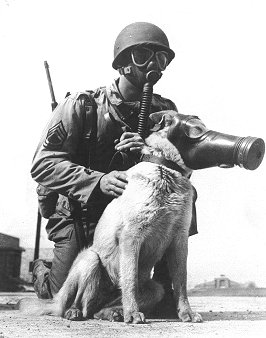
ABOVE: An early US Army photo of the E12R8 as worn. |
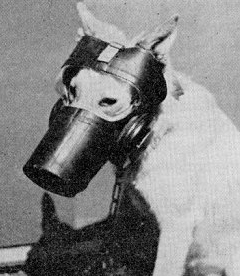
ABOVE: The M6-12-8 Dog Gas Mask as worn. |
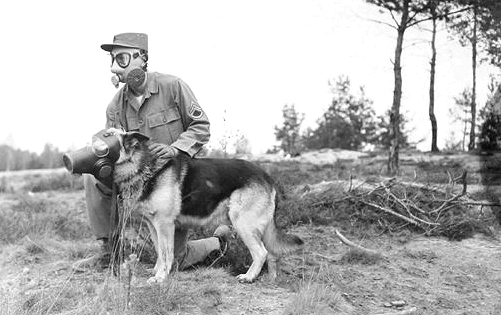
ABOVE: A post war photo of the M6-12-8 in use, circa mid 1950s. |
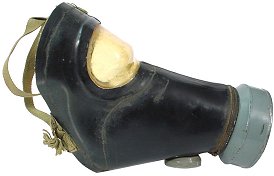 PROFILE
VIEW OF THE E12R8
PROFILE
VIEW OF THE E12R8 |
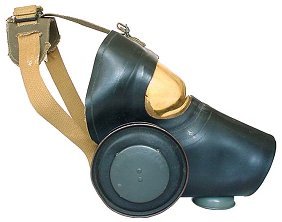 PROFILE
VIEW OF THE M6-12-8
PROFILE
VIEW OF THE M6-12-8 |
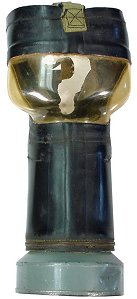 TOP
VIEW OF THE E12R8
TOP
VIEW OF THE E12R8 |
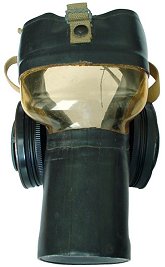 TOP
VIEW OF THE M6-12-8
TOP
VIEW OF THE M6-12-8 |
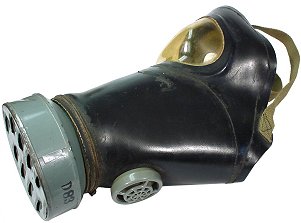 UNDERSIDE
OF THE E12R8
UNDERSIDE
OF THE E12R8 |
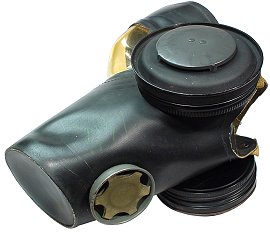 UNDERSIDE
OF THE M6-12-8
UNDERSIDE
OF THE M6-12-8 |
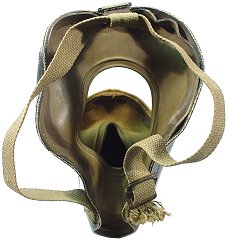 INNER VIEW THE OF THE E12R8
INNER VIEW THE OF THE E12R8 |
 INNER
VIEW THE OF THE M6-12-8
INNER
VIEW THE OF THE M6-12-8 |
 VIEW
OF THE FIXED E32R11 FILTER CANISTER ON
VIEW
OF THE FIXED E32R11 FILTER CANISTER ON
THE FRONT OF THE E12R8 DOG GAS MASK |
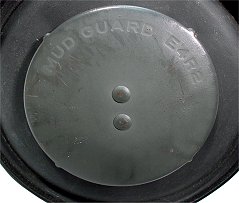 VIEW
OF THE M12 FILTER CANISTER AND E4R2 MUD
VIEW
OF THE M12 FILTER CANISTER AND E4R2 MUD
GUARD ON
THE M6-12-8 DOG GAS MASK |
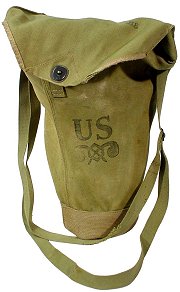 THE E12R8 PROPERLY STOWED IN ITS CARRIER
THE E12R8 PROPERLY STOWED IN ITS CARRIER |
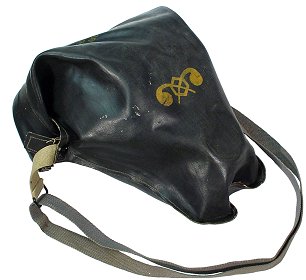 THE
M6-12-8 PROPERLY STOWED IN ITS CARRIER
THE
M6-12-8 PROPERLY STOWED IN ITS CARRIER |
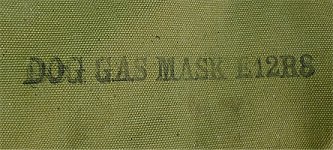 CLOSE-UP
VIEW OF THE MARKINGS ON THE CARRIER
CLOSE-UP
VIEW OF THE MARKINGS ON THE CARRIER
FOR THE E12R8 DOG GAS MASK |
 CLOSE-UP
VIEW OF THE MARKINGS ON THE CARRIER
CLOSE-UP
VIEW OF THE MARKINGS ON THE CARRIER
FOR THE M6-12-8 DOG GAS MASK |
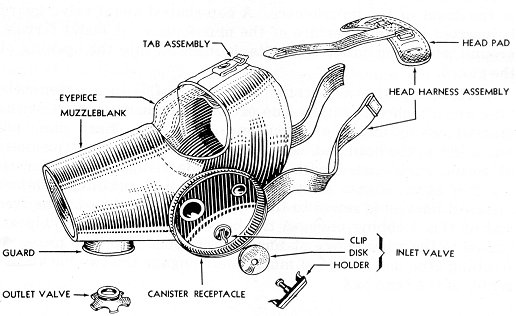 ABOVE: An exploded diagram of the M6-12-8 Dog Gas Mask.
ABOVE: An exploded diagram of the M6-12-8 Dog Gas Mask. |

ABOVE: Two soldiers and their K-9 companions undergo gas chamber training together, circa mid 1950s.
|
| REFERENCES
USED FOR THIS ARTICLE:
TM
3-205 - THE GAS MASK, MARCH 1951
THE CHEMICAL WARFARE SERVICE IN WWII:
A REPORT ON ACCOMPLISHMENTS, 1948
ARMY
CHEMICAL REVIEW: ANIMALS IN CHEMICAL WARFARE
By Major Robert D. Walk
U.S. CHEMICAL AND BIOLOGICAL DEFENSE RESPIRATORS
By Christopher T. Carey
CHEMICAL WARFARE SERVICE REPORT: D 6.6-1,
DOG GAS MASK, DECEMBER, 21 1942
*Special thanks to: Major Robert D. Walk for providing
some of these important historical photographs.
*Special thanks to: Ross Sandberg for additional photographs and documentation from the National Archives. |
 ABOVE: An early photo of the M6-12-8 as worn.
ABOVE: An early photo of the M6-12-8 as worn. |
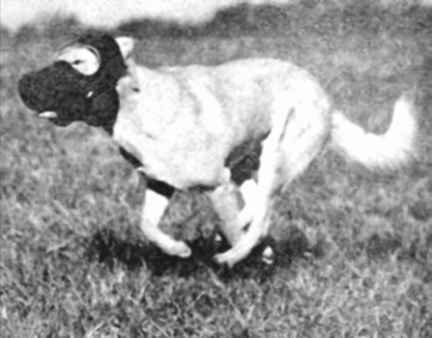 ABOVE: A rare photo of the M6-12-8 Dog Gas Mask in action!
ABOVE: A rare photo of the M6-12-8 Dog Gas Mask in action! |
© NO FUTURE PRODUCTIONS
|
|